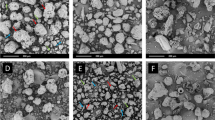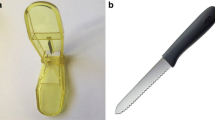Abstract
Purpose
Clinical practice suggests orally disintegrating tablets (ODTs) may be subdivided for dose adjustments, however there are no studies evaluating the effect of this practice in ODTs quality parameters. This work was therefore dedicated to elucidating the impact of the tablet subdivision on ten selected ODTs produced by different technologies.
Methods
Structural properties were assessed using weight; dimensions; image analysis; moisture content and porosimetry evaluations. Functional evaluations were also performed by disintegration and wetting assays. Tablets were evaluated just after subdivision and after an accelerated aging.
Results
Outcomes suggest the manufacturing method plays an important role in the suitability of ODTs for subdivision. While tablets containing granules immersed in a powdered matrix structure showed poor subdivision performance, with high weight variation and weight loss, tablets obtained by freeze-drying or direct compression of powder mixtures showed acceptable levels of these parameters and could be subdivided for immediate use. Aged tablets revealed structural and/or functional damages for all analyzed drug products, which includes softening of their matrices, water uptake and darkening, with loss of their disintegration and wetting capacities, which suggest inadequacy of ODTs subdivision for later use.
Conclusions
The results exposed in this study could be useful for the clinical decision on the subdivision of this tablets category.




Similar content being viewed by others
References
Rodenhuis N, De Smet PAGM, Barends DM. The rationale of scored tablets as dosage form. Eur J Pharm Sci. 2004;21:305–8.
Elliott I, Mayxay M, Yeuichaixong S, Lee SJ, Newton PN. The practice and clinical implications of tablet subdivision in international health. Tropical Med Int Health. 2014;19:754–60.
Sovány T, Kása P, Pintye-Hódi K. Modeling of subdivision of scored tablets with the application of artificial neural networks. J Pharm Sci. 2010;99:905–15.
Swaminathan S, Hilden J, Ramey B, Wassgren C. Modeling the formation of debossed features on a pharmaceutical tablet. J Pharm Innov. 2016;11:214–30.
Van Riet-Nales DA, Doeve ME, Nicia AE, Teerenstra S, Notenboom K, Hekster YA, et al. The accuracy, precision and sustainability of different techniques for tablet subdivision: breaking by hand and the use of tablet splitters or a kitchen knife. Int J Pharm. 2014;466:44–1.
Teixeira MT, Sá-Barreto LC, Gratieri T, Gelfuso GM, Silva IC, Cunha-Filho MS. Key technical aspects influencing the accuracy of tablet subdivision. AAPS PharmSciTech. 2017;18:1393–01.
Mandal TK. Effect of tablet integrity on the dissolution rate of sustained-release preparations. J Clin Pharm Ther. 1996;21:155–7.
Wilczyński S, Koprowski R, Duda P, Banyś A, Błońska-Fajfrowska B. Microtomographic studies of subdivision of modified-release tablets. Int J Pharm. 2016;511:899–12.
Basalious EB, Abdullah A, Ibrahim M. Utility of mannitol and citric acid for enhancing the solubilizing and taste masking properties of β-Cyclodextrin: development of fast-dissolving tablets containing extremely bitter drug. J Pharm Innov. 2014;9:309–20.
Slavkova M, Breitkreutz J. Orodispersible drug formulations for children and elderly. Eur J Pharm Sci. 2015;75:2–9.
Parkash V, Deepika HMS, Yadav S, Jogpal V. Fast disintegration tablets: opportunity in drug delivery system. J Adv Pharm Tech Res. 2011;2:223–35.
Blanco MA, Prieto M, Mearin F, Plazas MJ, Armengol S, Heras J, et al. Evaluation of preferences in patients with gastroesophageal reflux disease and dysphagia concerning treatment with lansoprazole orally disintegrating tablets. Gastroenterol Hepatol. 2009;32:542–8.
Sevilla C, Jiménez-Caballero PE, Alfonso V. Orally disintegrating donepezil: are the main caregivers of patients with Alzheimer's disease more satisfied with this formulation of donepezil than with the traditional one? Rev Neurol. 2009;49:451–7.
Stoltenberg I, Winzeburg G, Breitkreutz J. Solid oral dosage forms for children – formulation, excipients and acceptance issues. J Appl Ther Res. 2010;7:141–6.
Fu Y, Yang S, Jeong SH, Kimura S, Park K. Orally fast disintegrating tablets: developments, technologies, taste-masking and clinical studies. Crit Rev Ther Drug Carrier Syst. 2004;21:433–76.
Jeong SH, Takaishi Y, Fu Y, Park K. Material properties for making fast dissolving tablets by a compression method. J Mater Chem. 2008;18:3527–35.
Lin SY, Lin HL, Chi YT, Hung RY, Huang YT, Hsieh WH, et al. Influence of Soluplus on solid-state properties and physical stability of indomethacin-saccharin co-crystal formation prepared by air-drying process. J Pharm Innov. 2016;11:109–19.
Wu SH, Krieger DG, Park JH, Holman KM, Bish GA, Ramlose DS, et al. An alternative to the USP disintegration test for orally disintegrating tablets. Pharm Technol. 2008;32:1–6.
Hooper P, Lasher J, Alexander KS, Baki G. A new modified wetting test and an alternative disintegration test for orally disintegrating tablets. J Pharm Biomed Anal. 2016;120:391–6.
Sa-Barreto L, Alvarez-Lorenzo C, Martinez-Pacheco R, Gomez-Amoza JL. SEM-image textural features and drug release behavior of Eudragit-based matrix pellets. J Drug Deliv Sci Technol. 2017;42:292–8.
Teixeira MT, Sá-Barreto LCL, Silva DLM, Cunha-Filho MSS. Overview of regulatory aspects guiding tablet scoring. Rev Panam Salud Publica. 2016;39:372–7.
FDA. Food and Drug Administration, Understanding Generic Drugs, 2014.
McDevitt JT, Gurst AH, Chen Y. Accuracy of tablet subdivision. Pharmacotherapy. 1998;18:193–7.
Gupta A, Hunt RL, Khan MA. Influence of tablet characteristics on weight variability and weight loss in subdivided tablets. Am J Heal Pharm. 2008;65:2326–8.
Hill SW, Varker AS, Karlage K, Myrdal PB. Analysis of drug content and weight uniformity for half-tablets of 6 commonly subdivided medications. J Manag Care Pharm. 2009;15:253–61.
Helmy SA. Tablet subdivision: is it worthwhile? Analysis of drug content and weight uniformity for half tablets of 16 commonly used medications in the outpatient setting. J Manag Care Spec Pharm. 2015;21:76–86.
Kulinowski P, Woyna-Orlewicz K, Obrał J, Rappen GM, Haznar-Garbacz D, Węglarz WP, et al. Multimodal approach to characterization of hydrophilic matrices manufactured by wet and dry granulation or direct compression methods. Int J Pharm. 2016;499:263–70.
FDA. Food and Drug Administration, guidance for industry: orally disintegrating tablets, U.S. Department of Health and Human Services, 2008.
Acknowledgements
This research was financially supported by the Brazilian agency FAPDF (Grant n. 0193.001023/2015).
Author information
Authors and Affiliations
Corresponding author
Rights and permissions
About this article
Cite this article
Temer, A.C., Teixeira, M.T., Sa-Barreto, L.L. et al. Subdivision of Tablets Containing Modified Delivery Technology: the Case of Orally Disintegrating Tablets. J Pharm Innov 13, 261–269 (2018). https://doi.org/10.1007/s12247-018-9323-3
Published:
Issue Date:
DOI: https://doi.org/10.1007/s12247-018-9323-3




